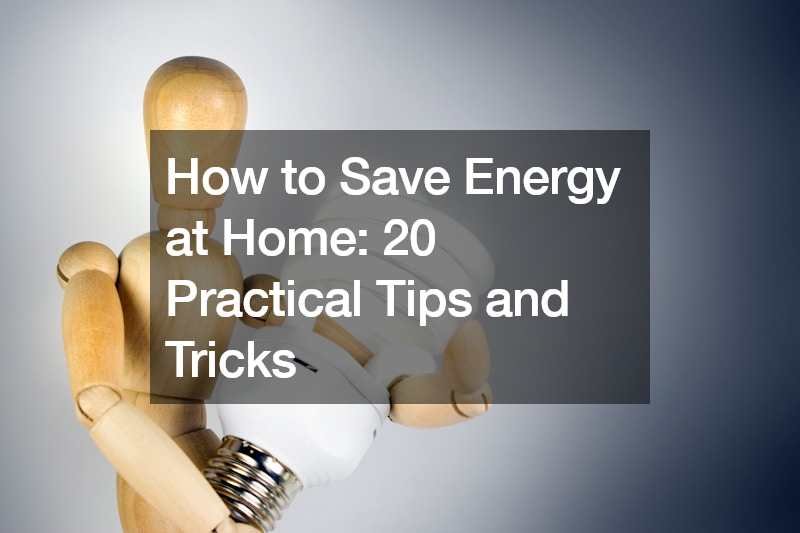
In today’s world, where energy costs are constantly on the rise, finding ways to reduce energy consumption at home has become increasingly important. By adopting simple yet effective strategies, you can not only lower your energy bills but also contribute to a more sustainable future. Here are 20 practical tips and tricks to help you save energy at home:
1. Upgrade to LED Lighting: One of the easiest ways to save energy at home is by replacing traditional incandescent bulbs with energy-efficient LED or CFL bulbs. LED bulbs use significantly less energy and last longer, helping you cut down on electricity costs.
2. Service Your Heating System Regularly: Ensure that your heating system is operating at peak efficiency by scheduling regular maintenance. Consider upgrading to a more energy-efficient system if your current one is outdated or inefficient.
3. Optimize Thermostat Settings: Adjust your thermostat settings to optimize energy usage. Lower the temperature during the winter months and raise it in the summer to reduce heating and cooling costs.
4. Install a Programmable Thermostat: Invest in a programmable thermostat to automatically adjust temperature settings based on your schedule. This can help you save energy by optimizing heating and cooling cycles.
5. Seal Air Leaks: Identify and seal any air leaks around windows, doors, and other openings to prevent heat loss. Use weather stripping and caulking to seal gaps and cracks, improving energy efficiency.
6. Upgrade Insulation: Improve insulation in your home to minimize heat loss and reduce energy consumption. Add insulation to walls, attics, and crawl spaces to maintain comfortable indoor temperatures year-round.
7. Install Energy-Efficient Windows: Replace old windows with energy-efficient models to improve insulation and reduce heat transfer. Look for windows with low-emissivity coatings and double or triple glazing for maximum efficiency.
8. Use Energy-Efficient Appliances: Upgrade to ENERGY STAR certified appliances, such as refrigerators, washing machines, and dishwashers, to reduce energy consumption. These appliances are designed to operate more efficiently, saving you money on electricity bills.
9. Unplug Electronics When Not in Use: Turn off and unplug electronics and appliances when they’re not in use to eliminate standby power consumption. Use power strips to easily switch off multiple devices at once.
10. Utilize Natural Light: Take advantage of natural light during the day by opening curtains and blinds. This can help reduce the need for artificial lighting, saving energy and lowering electricity bills.
11. Air Dry Laundry: Instead of using a clothes dryer, air dry your laundry outdoors or indoors on a drying rack. This eliminates the energy consumption associated with machine drying and prolongs the life of your clothing.
12. Cook Efficiently: Use energy-efficient cooking methods, such as microwaving, boiling, or using a slow cooker, to minimize energy usage in the kitchen. Opt for smaller appliances when possible and avoid preheating the oven unnecessarily.
13. Reduce Water Heater Temperature: Lower the temperature setting on your water heater to save energy and reduce heating costs. Most households can comfortably set their water heater to 120°F (49°C) without sacrificing comfort.
14. Upgrade to High-Efficiency Showerheads and Faucets: Install low-flow showerheads and faucets to reduce water usage and energy consumption associated with heating water. These fixtures can significantly decrease water and energy bills without compromising performance.
15. Insulate Hot Water Pipes: Wrap hot water pipes with insulation to minimize heat loss and reduce energy waste. This helps maintain hot water temperatures while reducing the need for the water heater to work harder.
16. Plant Shade Trees: Strategically plant shade trees around your home to block direct sunlight during the summer months. This can help reduce cooling costs by keeping your home cooler naturally.
17. Utilize Ceiling Fans: Use ceiling fans to improve air circulation and distribute heat more efficiently during the winter. Set fans to rotate clockwise at a low speed to push warm air down from the ceiling.
18. Implement Energy-Saving Landscaping: Choose energy-efficient landscaping features, such as native plants and mulch, to reduce water consumption and lower outdoor maintenance needs. This can help conserve resources and save on energy costs associated with landscaping.
19. Conduct an Energy Audit: Schedule a professional energy audit to identify areas of energy waste and opportunities for improvement in your home. This comprehensive assessment can provide valuable insights and recommendations for maximizing energy efficiency.
20. Educate Yourself and Others: Stay informed about energy-saving practices and share tips with family, friends, and neighbors. By raising awareness and promoting energy conservation, you can contribute to a more sustainable future.
By incorporating these practical strategies into your daily routine, you can significantly reduce energy consumption, lower your utility bills, and create a more energy-efficient home environment. Saving Energy at Home is not only beneficial for your finances but also for the planet. Let’s work together to make a positive impact and conserve energy for generations to come.
.

